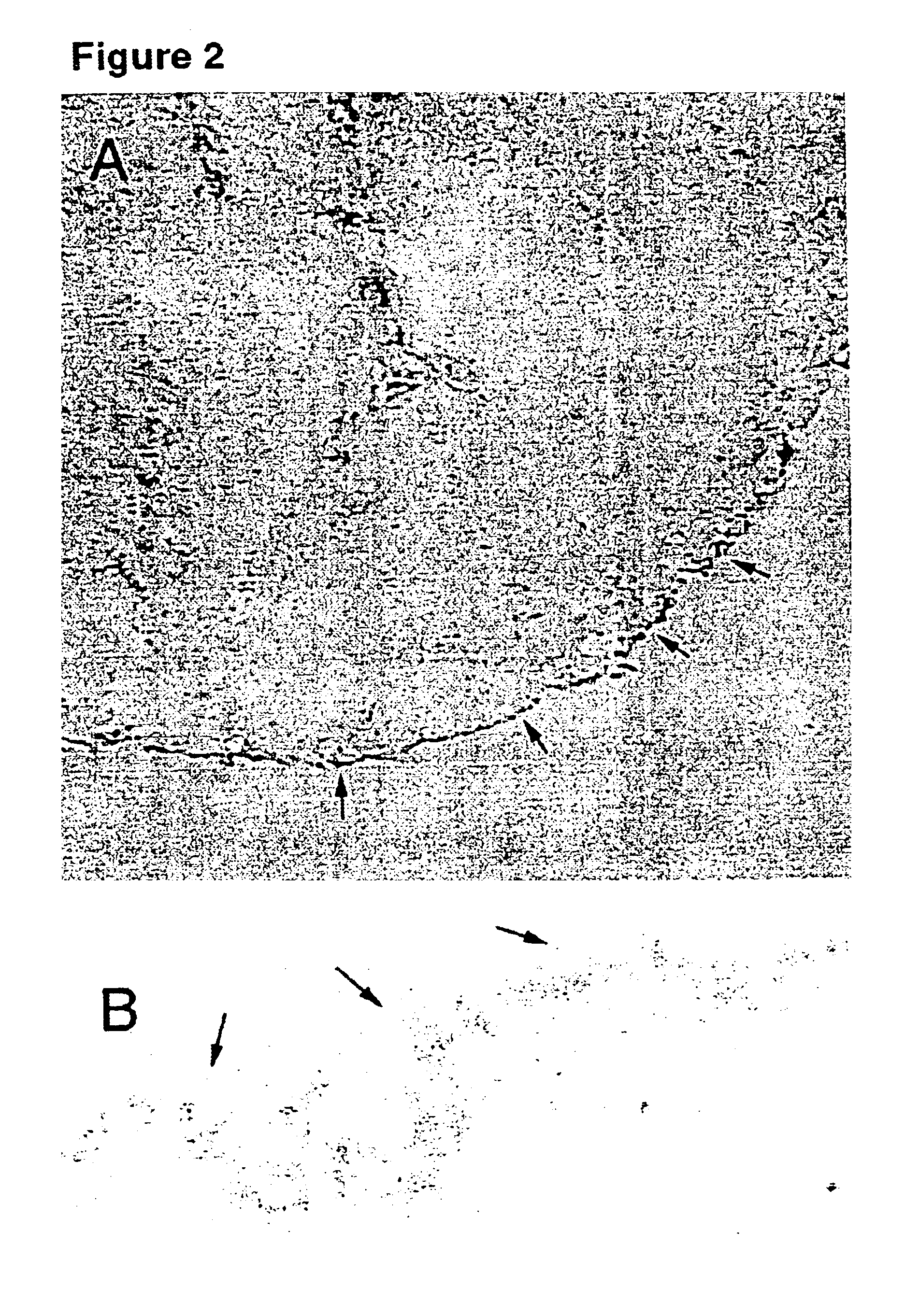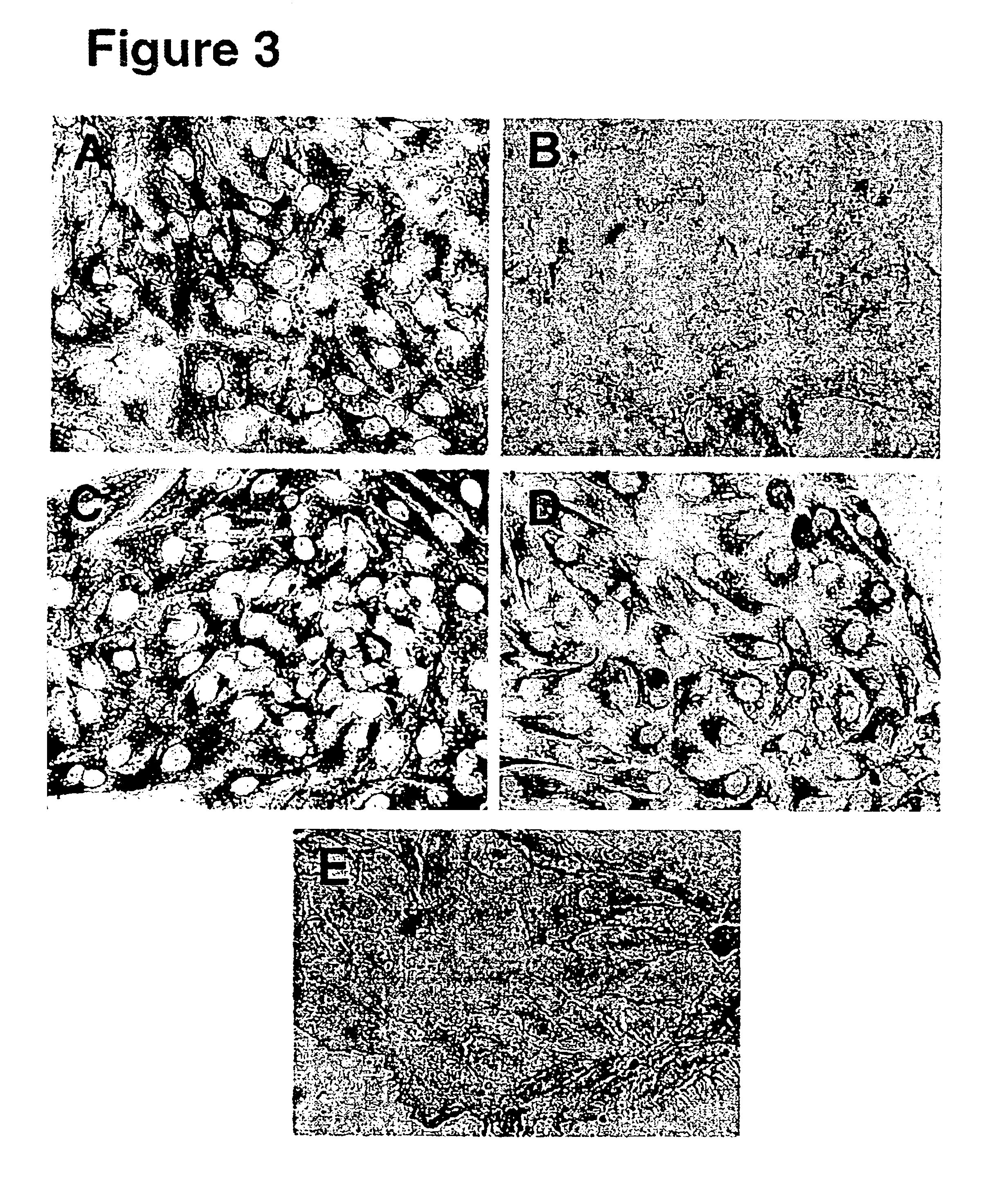Human ovarian mesothelial cells and methods of isolation and uses thereof
a technology of ovarian mesothelial cells and methods, applied in the field of development biology and cell biology, can solve the problems of human ovary tissue models, difficult efforts to confirm the ovarian surface epithelium as the source of cancerous growth, and lack of understanding about the development of ovarian surface epithelial cells
- Summary
- Abstract
- Description
- Claims
- Application Information
AI Technical Summary
Benefits of technology
Problems solved by technology
Method used
Image
Examples
example 1
Isolation and Culturing of Ovarian Mesothelial Cells
[0068]Human fetal ovaries of gestational age between 17 to 25 weeks were obtained from Advanced Bioscience Research at Alameda county, Calif. Ovaries were procured and shipped to the lab in tissue culture medium under wet ice bath. Immediately upon arrival, the ovaries were cleaned of excess connective tissues, carefully separated from fallopian tube, and washed five times with fresh tissue culture medium.
[0069]The ovaries were minced with scissors or cut into small pieces (less than 1 mm thick) with a razor blade. The tissue pieces from each ovary were plated directly in a T75 flask freshly coated with laminin with 10 ml preferred nutrient medium as disclosed herein. Further dissociation of the ovaries with collagenase-dispase (0.5%) for 30 minutes at 37° C. could be done, but the procedure reduced the recovery of ovarian mesothelial cells. The cells were cultured in F12 / DMEM supplemented with 10 μg / ml insulin, 10 μg / ml transferri...
example 2
Characterization of Ovarian Mesothelial Cell Lines
[0070]Ovarian mesothelial cells were harvested from suspension cultures. To directly stain the cells in cluster form, the cell clusters were embedded in optimal cutting temperature (OCT) compound and frozen on dry ice. Cryosections (5-10 μm thick) were cut of the OCT blocks, thaw-mounted onto coverslips, and fixed in 3% paraformaldehyde for 1 hour. A monolayer culture of ovarian mesothelial cells was prepared by plating the cell clusters from the suspension culture on chamber slides in the presence of 2% BSA. The monolayer cell cultures were fixed in situ with 3% paraformaldehyde for 1 hour. After the fixative was washed away with phosphate buffered saline (PBS), the cells were incubated in blocking buffer (5% goat serum and 0.1% Tween 20 in PBS) for 30 minutes, rinsed with PBS, then incubated in primary antibodies for 1 hour, rinsed with PBS, and then incubated with anti-mouse Ig-horseradish peroxidase for 1 hour. The markers and ex...
example 3
Method of Providing a Source of an Immunogen to Produce Monoclonal Antibodies Against Ovarian Mesothelial Cells
[0071]Ovarian mesothelial cells were isolated and cultured as disclosed and then subsequently used as an immunogen to produce a panel of monoclonal antibodies against ovarian mesothelial cells. Mice were each immunized with one injection of about 1×106 cells of ovarian mesothelial cells per week. The immunization was localized into the foot pads of each mice. After 5 injections, the mice were bled to check the titer of ovarian mesothelial cells. When the titer of ovarian mesothelial cells rose above 1:1000 (ovarian cell:total cells) in a mouse, the mouse was sacrificed and lymph nodes were harvested. Lymphocytes were prepared from the lymph nodes and fused to myeloma cell line to produce a hybridoma. Hybridomas were screened by flow cytometry (fluorescence-activated cell sorter or FACS) as well as by immunohistochemistry for monoclonal antibodies that specifically bound to ...
PUM
| Property | Measurement | Unit |
|---|---|---|
| thick | aaaaa | aaaaa |
| thick | aaaaa | aaaaa |
| size | aaaaa | aaaaa |
Abstract
Description
Claims
Application Information
 Login to View More
Login to View More - R&D
- Intellectual Property
- Life Sciences
- Materials
- Tech Scout
- Unparalleled Data Quality
- Higher Quality Content
- 60% Fewer Hallucinations
Browse by: Latest US Patents, China's latest patents, Technical Efficacy Thesaurus, Application Domain, Technology Topic, Popular Technical Reports.
© 2025 PatSnap. All rights reserved.Legal|Privacy policy|Modern Slavery Act Transparency Statement|Sitemap|About US| Contact US: help@patsnap.com



